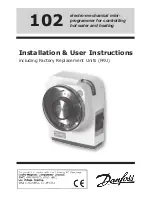
- 5 -
J. Data TX and RX terminals (not used)
Intended for factory diagnostic testing only. Do not connect any wires to the Data TX
or Data RX terminals (#11 and #12 in diagram).
I. Install Stator-In And Tach-Out Wires
When an electric tachometer is used, the alternator’s stator output will provide the
electrical pulse needed to drive the tachometer. The MC-612 has been designed to
provide regulated tach output when the WHITE stator wire is connected to the regu-
lator’s Stator In (#9 in diagram) terminal and the outfeed wire to the electric
tachometer is connected to the Tach Out terminal (#10 in diagram). When the
tachometer is connected via the MC-612, the regulator will ensure that the tachome-
ter will not drop out when the batteries are fully charged.
When connecting the tachometer to the alternator stator output, it will be necessary
to determine the number of poles in the alternator in order to properly adjust your
tachometer. Most Balmar alternators feature 12-pole rotors and stators, though, in
some cases, the pole count may be 14. See alternator manual for specifics. See your
tachometer manual for adjustment instructions.
K. Initial Start-Up
With all of the wiring connections installed between the alternator and voltage regulator, as described in steps
C through J, the regulator is ready for initial start up. To test the regulator for proper operation:
A. Reconnect the battery cables to the batteries and turn battery switches to the on position.
B. Turn the ignition switch to the ON position. If the regulator’s BROWN ignition wire was connected to an
oil pressure switch, it may be necessary to start the engine. If that is necessary, be sure to inspect for any
loose or disconnected wires, inspect and adjust alternator belt tension if necessary.
C. With the ignition on and/or with the engine running, the regulator’s LED should scroll through the basic
regulator display. If the engine is running, the charging voltage will begin to climb to 14.1 volts.
IV. Optional Wiring Connections
Once the regulator is up and functioning, you can shut it down and continue the
installation of the remaining wiring options, or continue on to the Basic Programming
instructions in Section V.
A. Install Alternator Temperature Sensor
The optional Alternator Temperature Sensor (MC-TS-A) allows your Max Charge
voltage regulator to monitor your alternator for temperatures in excess of safe oper-
ating levels. The MC-TS-A sensor assmbly includes a 54” cable, a sensing attachment
lug and positive and negative regulator plug-in connectors. To install the MC-TS-A:
1.
Connect the sensor lug to one of the four bolts that hold the alternator’s front and rear
cases together. See photo at right.
2.
Extend sensor cable to the regulator. The cable can be included within the regulator’s
wiring harness, or can be run alongside the harness and attached with cable ties.
3.
Connect the positive and negative female connectors to the Alternator Temp. Sense ter-
minals on the regulator (#13). It is essential that the terminals match the polarity of the
regulator connection pins (red wire to positive terminal and black wire to negative ter-
minal). See the legend on the side of the regulator to determine terminal polarity.
Small Engine Mode
The MC-612 can be switched to provide a half-power setting by installing a toggle switch between the positive and negative termi-
nals of the alternator temp sensor circuit. When activated by closing the switch, the regulator reduces the alternator output by a max-
imum 50%. This mode is ideal for smaller engines that are not capable of providing suitable horsepower to drive both the alterna-
tor and propeller at full output. When in Small Engine Mode, the regulator will send a signal to the Aux. 1 Output.
Summary of Contents for Max Charge MC-612
Page 15: ...15...



































